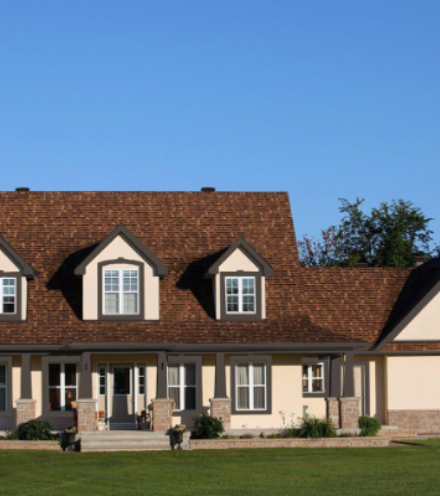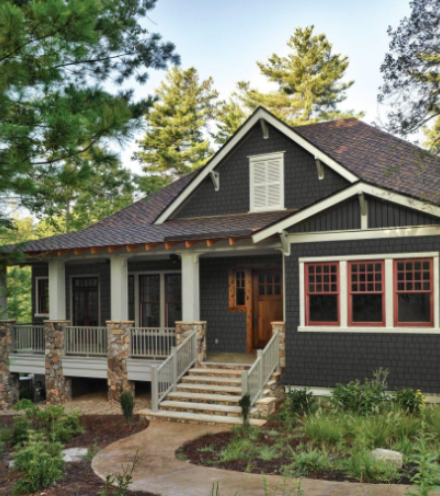A vital consideration in the home building industry is building with durable, weather-resistant lap siding. Many builders build with fiber cement siding because wind, rain, snow, cold, drought, heat and sun all affect the condition of your home and extreme weather can have a severe impact on its structure. Home builders are knowledgeable about the weather conditions in their area and build homes with materials that are best suited to the environment.

Here is how weather conditions take their toll on a home.
Wind
Wind can cause two conditions: up-lift and racking. Up-lift develops when rapidly moving wind creates an area of lower pressure on the leeward roof slope, walls, and inside the house. The home’s inside pressure can push the structural components outward. Homebuilders use special connections to attach the roof to the house in areas that experience extreme conditions such as hurricanes and tornadoes. Racking can occur when the high wind forces do not hit the house squarely. The home’s framing will usually withstand the racking force, but extremely high winds can tear shingles off the roof. The wind can also create major damage by driving rain up under roof shingles, vertical siding, window frames, doors and roofs. It is important all these construction materials are properly installed and maintained to avoid damage to your home.
Rain
Sometimes the more creative architects are, the more vulnerable a home is to rain damage because there are more design breaks in the walls and roof. These breaks can be susceptible to water penetration if not properly sealed and maintained. Rain can damage your home in two main areas. First, installation of chimneys, skylights and plumbing vents all create “penetrations” in the roof which are sealed with flashing, caulk and roof cement. All sealing methods eventually expand, dry out and erode so sealing material must be inspected annually and replaced or repaired to prevent water damage. The second concern is the home’s foundation. The stability of the house depends on the ability of the soil to absorb rain. When soil becomes saturated and can no longer absorb and drain the water, leaks can occur in basements and crawl spaces; and in extreme cases, cause the foundation to shift. Home builders construct homes so they stand up to soil conditions in their particular area of the country.
Snow
The amount of snowfall is also considered in a home’s design. Snow is very heavy. Light snow weighs about 10-15 pounds per cubic foot. Heavy, wet snow can weigh up to 40-50 pounds per cubic foot. Building codes in some mountainous areas of the country require roofs to be designed for as much as 400 pounds per square foot which is the equivalent of 6 feet of water on the roof. Homes are designed to withstand the weight of the snow to eliminate sagging, cracking and collapsing roofs. There is a benefit to snow, however, it is a good insulator. Snow piled around foundations and the roof will help hold heat in homes and reduce heating costs. Winters with little snowfall actually result in higher heating costs.
Heat and Sun
The heat from the sun is another natural force that builders consider when choosing building materials that are best suited to the climate. The sun can cause a home to dry out and prematurely age. Roofing materials can wear significantly faster in warmer climates than in moderate ones. It is a good idea to install an attic fan or ridge vents around the attic access door to help release the hot air because the heat in attics can also cause the wood to dry out. These devices can reduce the cost of cooling your home. Homeowners should always consider fans and vents when re-roofing an older home. Another consideration is the color of a home. Air conditioners will work harder in darker colored homes than in lighter ones because dark colors absorb more heat than lighter colors. Unfortunately, areas like the desert usually experience both the extreme heat and the extreme cold causing cracks and voids to develop because of unequal rates of expansion. Builders in desert regions choose materials that react favorably to the extremes and deteriorate less quickly.
Drought
Drought can cause soil, such as clay, to shrink and crack and puts stress on a home’s foundation that can be costly to fix. Conversely, water can cause certain soils to expand and damage a home’s foundation. Builders in areas with these types of soils build houses on foundations designed to allow for the stress so the foundation remains stable. Drought also has an effect on wells because it lowers the water table. Water can become polluted with sediments and unfit for drinking. Homeowners who use well water need to have the water tested for purity regularly.
Siding needs to be ready for anything – extreme weather, moisture, fire, and pests. From scorching desert terrain to frigid tundra, Allura’s first-rate product formula is built to perform for generations.
Source: mba.org




